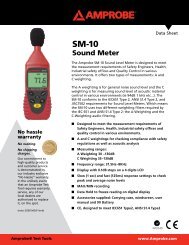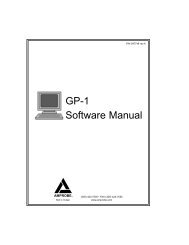AC40C AD40B - Amprobe
AC40C AD40B - Amprobe
AC40C AD40B - Amprobe
Create successful ePaper yourself
Turn your PDF publications into a flip-book with our unique Google optimized e-Paper software.
• Never ground yourself when taking measurements. Do not<br />
touch exposed metal pipes, outlets, fixtures, etc., which<br />
might be at ground potential. Keep your body isolated from<br />
ground and never touch exposed wiring, connections, test<br />
probe tips, or any live circuit conductors.<br />
• Do not operate the instrument in an explosive atmosphere<br />
(flammable gases, fumes, vapor, dust).<br />
• Do not use this or any piece of test equipment without<br />
proper training. Read the operating instructions before use<br />
and follow all safety instructions.<br />
• Use the meter only as specified in this manual; otherwise the<br />
meters safety circuitry may not protect you.<br />
• Use extreme caution when working around bare conductors.<br />
Contact with the conductor could result in electric shock.<br />
• The ridge at the top of the clamp body is intended to keep<br />
hands and fingers away from hazardous live conductors.<br />
Introduction<br />
The <strong>AD40B</strong> is an average sensing and RMS (sine wave) indicating<br />
AC current clamp. The <strong>AC40C</strong> is an average sensing and RMS<br />
(sine wave) indicating AC current clamp meter that also<br />
measures AC and DC voltage, resistance and continuity.<br />
Unpacking and Inspection<br />
Your shipping carton should include the digital clamp meter ,<br />
a carrying case, two 1.5 V AAA (UM-2) batteries (installed), and<br />
this manual plus one test lead set (one black, one red) for the<br />
<strong>AC40C</strong> meter. If any of the items are damaged or missing, return<br />
the complete package to the place of purchase for an exchange.<br />
AC Current Measurement (Fig. 1)<br />
1. Set the slide switch to ACB position.<br />
2. Open spring-loaded clamp by pressing lever on left side of<br />
meter.<br />
3. Position clamp around wire or conductor and release clamp<br />
lever. Make sure that the conductor is centered in the clamp<br />
and that the clamp is entirely closed. The clamp must be<br />
positioned around only one conductor. If it is placed around<br />
two or more current carrying conductors, the reading is<br />
FALSE.<br />
4. Read the measured value on the display. If the measured<br />
value exceeds the highest range for a period of time,<br />
overheating may occur. Interrupt measurement.<br />
6




